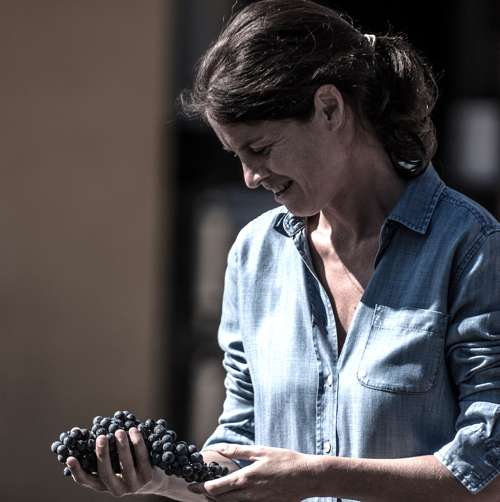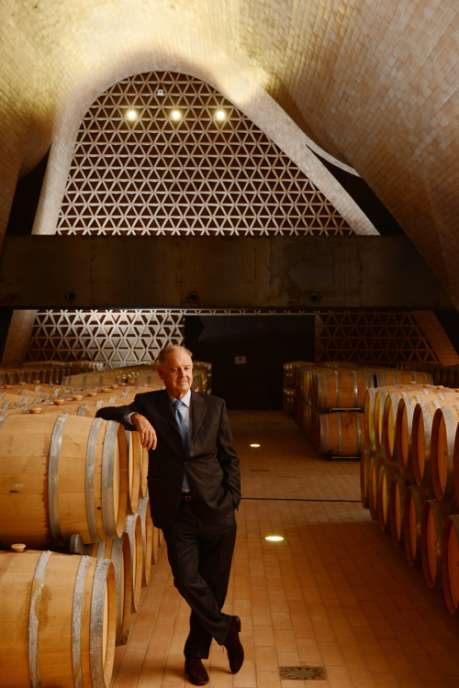Alessia Antinori makes great wine and keeps art in the recipe
Alessia Antinori–who with her sisters are the first women to run their family’s legendary winery in its 632-year-old history–looks to art, native varietals, and girl-power marketing to keep the legendary brand on top of its game.

“The woman’s role in our business, especially in Italy in the past, was something that was considered unattainable,” says Alessia Antinori, who with her sisters Albiera and Allegra are the heirs to Marchesi Antinori, one of the oldest wineries in the world, and its first female management team in the company’s storied history.
And it might have remained out of reach for this generation of Antinori women, except for a twist of fate and a father who saw possibilities for his young daughters, even though he was reluctant to impose his hopes for continuity upon them. Since its founding in 1385 (yes, in the 1300s), the ownership of theTuscan-based winery passed smoothly, like an English title, from father to son for 25 generations. That in itself is a mind-boggling feat, considering the Antinori winery, which started in the Middle Ages, has survived in a country that has endured countless invasions and two devastating World Wars. Historically, most businesses, even those launched during robust peacetime economies, never make it beyond the rst decade.
Despite the travails, Marchesi Antinori not only endured but thrived. In the past 50 years, Piero, the Antinori sisters’ father, had brought the famed winery even greater renown, reviving Chianti Classico and introducing a new category of wine, the Bordeaux-like Super Tuscans in the 1970s. Yet for all his success, Piero was faced with a challenge his ancestors, over the course of six centuries, never had: There were no sons to carry on the business. While primogeniture isn’t a factor in Italy—no distant cousin stood in the wings to inherit the estates—the country’s wine sector had always been a tight-knit male club, unlike the fashion world where women had long played prominent roles (e.g., Rosita Missoni, Wanda Ferragamo, Mariuccia Manelli at Krizia).

And while women had begun to make great professional strides in the U.S. and the UK, progress moved at a slower pace in southern European countries. In 1981, concerned that an An- tinori wouldn’t be at the helm when he retired, Piero even sold a chunk of it to Whitbread, the UK’s largest hospitality compa- ny. But when the Whitbread and Antinori merger didn’t go as smoothly as planned—the cultures didn’t mesh—Piero looked hard at the winery’s future again. He bought back the Whitbread shares a decade later, during which time his daughters, growing up as modern women in a more forward-looking Europe, began to show interest in the business.
Initially the sisters’ involvement was gradual—Piero never wanted to push them into a commitment—but as they grew in their jobs, they saw how their positions not only provided meaningful careers but also the chance to retain a connection to a revered way of life, to the land generations of their forbearers had overseen. It was an opportunity that no corporate position or other business could ever provide. “At heart we are farmers,” Albi- era told Morley Safer during a 60 Minutes interview.

As such, the three sisters began their work, including in the fields, helping to cull grapes for the annual vendemmias, then moved into management roles. Alessia studied vitculture and enology at the University of Milan’s agriculture school (and was one of only two women in her class). To better understand the American market, Antinori’s most important outside Italy, Alessia moved to New York for a number of years. In 2016, when their father announced he would soon retire (Piero is honorary president, but he remains involved in the business), Albiera, who holds the title of president, and Alessia and Allegra, both of whom are vice presidents, along with the company’s CEO, Renzo Cotarella, began running the day-to-day operations of the company, which produces more than 11 million bottles of wine a year.
Now immersed in their careers at the winery, Alessia says that female leadership has had a meaningful impact on the company’s 21st-century strategies. “We brought fresh points of view to marketing and sales,” she says, something all legacy companies need, but particularly those in the wine business, where women now make more wine purchases than men (according to the Wine Institute, approximately 57 percent of sales in the U.S.). Alessia notes that the female perspective is playing out in other areas of the business too, including the critical area of tasting. When judging the viability of a vintage, “the female palate can be in- credibly precise,” she says.
Alessia and her sisters know that while their heritage is the backbone of the company, its future success depends on their continued ability to evolve and innovate, something their father excelled at and gave him international renown. During his five- decade tenure at the helm, Piero raised the visibility and prestige of Italian wines worldwide put his mark on the company through the game-changing development of the Super Tuscans and superior Chianti Classicos, along with buying wine estates outside Tuscany in Piedmont, Puglia, Napa, Hungary, and other locales and building a 21st-century winery in Bargino.
Evolution for a modern wine business isn’t restricted to tech innovation—state-of-the-art fermentation tanks, vine-manage- ment so ware, or the latest destemming devices—all those can certainly help the vintner make his or her job more e cient. Wine, for now at least, remains a natural commodity—ground- breaking products still must start in the ground. Famous for its reds, Antinori will continue to develop new wines, says Alessia, made not only with Tuscan mainstays like the Sangiovese grape, but with indigenous grapes from Piedmont (Nebbiolo) and Puglia (Negroamaro and Aglianico). Developing native varietals will help the company produce what it sees as a growing interest in structured red wines “with a lot of character.” Despite the fact that experimenting with these varietals can be, as she puts it, “very challenging”—she extolls what her father calls the three P’s— patience, passion, and perseverance—qualities that have kept the company’s wine production in good stead for centuries. When the resoluteness pays o , the result is always a “unique” bottle of wine, she says. While Antinori has long been de ned by its reds, Alessia and her sisters will also look to develop more white wines. “Now, more than ever, consumers are interested in them,” she says.
One area of the family business that Alessia has claimed for her- self is the Antinori Art Project, which like the winery itself draws on the company’s long history—in this case its collection of ne and decorative art (part of which is now housed at the Marchesi Antinori Chianti Classico Cellar in Bargino)—while leveraging that heritage to nurture contemporary talents. “We have always been involved in art, because as Florentines we have always been surrounded by great examples of it,” Alessia says. “So our connection to and support of the arts has been very natural to us.” The Antinori arts initiative, celebrating its fifth anniversary this year, has developed partnerships with contemporary artists like Rosa Barba, known for her cinematic art installations; Jean-Baptiste Decavèle, a French multimedia artist; and Tomás Saraceno, whose workincludes interactive installations and oatingsculptures. The Antinoris have also enlisted top curators—Chiara Rusconi, who helmed arts programs at Monnaie de Paris, and Ilaria Bonacossa, head of Artissima, the Turin-art fair—to work with them on the projects, which Alessia notes will one day be considered as “classic” or as “vintage” as the Della Robbia lunette featuring an Antinori ancestor, currently on display at the National Gallery of Art, in Washington, D.C. (until June 4, 2017).
Alessia, as the “New York” Antinori, has been a member of the Council of the Museum of Modern Art since 2001. Her time spent in New York has not only fueled her passion for art, it has helped her understand the dynamics of a huge, ever-evolving con- sumer market vital to Antinori. “I learned the importance of maintaining a family presence here,” Alessia says, noting she makes frequent trips to New York and throughout America. “In the U.S., customers are becoming increasingly interested in putting a face to the products they are consuming, and in our case that means meeting the winemaker and owner. And by meeting customers face-to-face, we are able to better understand mar- ket trends and taste preferences.”

As for her own wine preferences she says, it can depend on the time of year. “Year-round I enjoy a glass of Marchese Antinori rosé or Marchese An- tinori Chianti Classico Riserva. In the summer, I like the fruity Vermentino from our Guado al Tasso estate. I find the Bruciato from the same estate to be the perfect everyday wine. For special occasions, our Badia a Passignano Chianti Classico Gran Selezione is perfection.” She feels a day without wine is like a day “without a sunset.”
Asked which of the many wines that Antinori produces best typi es the company, she answers without hesitation: Tignanello. “It is the essential Antinori wine, a symbol of tradition and innovation. As one of the rst Super Tuscans, it helped forge a wine category that went against the rules and catalyzed the renaissance of high-quality Italian red wines in the 1970s.”
By being the first female management team at Antinori, Alessia and her sisters are writing their own rules, too, but are also proud of the fact that “it’s no longer unique to be a woman in the wine world.” (Today, some 40 percent of Antinori employees are women.) Still they know they are pioneers whose work will be closely watched and followed, just as the work of their father and ancestors has been watched and followed for hundreds of years. The Antinori sisters are still young, but they know that an important part of their job will be not only to innovate and develop new wines but also to hand over a well-run, financially sound company to the 27th generation, which no doubt will have many women eager to take the reins in its mix.












